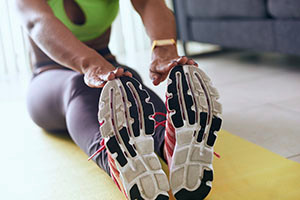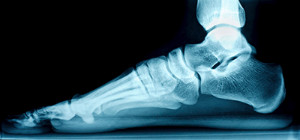Mild Relief Options for Hammertoe
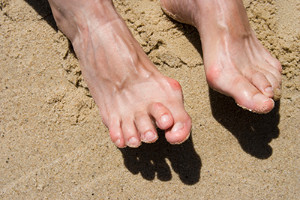 Hammertoe is a noticeable foot condition that many people experience. It is characterized by an upward bend in the middle joint of the second or third toe, and can often cause difficulty in wearing shoes. This ailment can be prompted by having certain medical conditions, such as diabetes. Additionally, many patients develop hammertoe from wearing shoes that do not have adequate room for the toes to move freely in. Mild relief may be found when specific stretches are performed on the toes, and it may help to wear protective pads on top of the affected toes. If you have hammertoe, please consult with a podiatrist. A podiatrist can offer treatment options which may include surgery that can permanently straighten the toe.
Hammertoe is a noticeable foot condition that many people experience. It is characterized by an upward bend in the middle joint of the second or third toe, and can often cause difficulty in wearing shoes. This ailment can be prompted by having certain medical conditions, such as diabetes. Additionally, many patients develop hammertoe from wearing shoes that do not have adequate room for the toes to move freely in. Mild relief may be found when specific stretches are performed on the toes, and it may help to wear protective pads on top of the affected toes. If you have hammertoe, please consult with a podiatrist. A podiatrist can offer treatment options which may include surgery that can permanently straighten the toe.
Hammertoes can be a painful condition to live with. For more information, contact Jim Maxka, DPM of South Penn Foot & Ankle Associates. Our doctor will answer any of your foot- and ankle-related questions.
Hammertoe
Hammertoe is a foot deformity that occurs due to an imbalance in the muscles, tendons, or ligaments that normally hold the toe straight. It can be caused by the type of shoes you wear, your foot structure, trauma, and certain disease processes.
Symptoms
- Painful and/or difficult toe movement
- Swelling
- Joint stiffness
- Calluses/Corns
- Physical deformity
Risk Factors
- Age – The risk of hammertoe increases with age
- Sex – Women are more likely to have hammertoe compared to men
- Toe Length – You are more likely to develop hammertoe if your second toe is longer than your big toe
- Certain Diseases – Arthritis and diabetes may make you more likely to develop hammertoe
Treatment
If you have hammertoe, you should change into a more comfortable shoe that provides enough room for your toes. Exercises such as picking up marbles may strengthen and stretch your toe muscles. Nevertheless, it is important to seek assistance from a podiatrist in order to determine the severity of your hammertoe and see which treatment option will work best for you.
If you have any questions, please feel free to contact our office located in Hanover, PA . We offer the newest diagnostic and treatment technologies for all your foot care needs.
What Can Cause Cracked Heels?
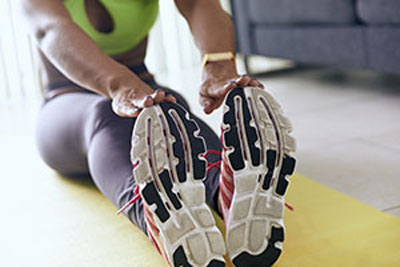 A common foot condition that can affect many patients is known as cracked heels. Cracked heels may develop as a result of standing on hard surfaces for the majority of the day or from wearing shoes that have an open back. The body’s natural defense of protecting damaged skin is thickening the skin, which often precedes cracked heels. Deep and painful cracks are referred to as fissures and can develop if this condition is left untreated. Mild relief can be found when the feet are soaked in warm water, followed by applying a good moisturizer to the affected area. If you have developed cracked heels, please consult with a podiatrist who can effectively treat this ailment.
A common foot condition that can affect many patients is known as cracked heels. Cracked heels may develop as a result of standing on hard surfaces for the majority of the day or from wearing shoes that have an open back. The body’s natural defense of protecting damaged skin is thickening the skin, which often precedes cracked heels. Deep and painful cracks are referred to as fissures and can develop if this condition is left untreated. Mild relief can be found when the feet are soaked in warm water, followed by applying a good moisturizer to the affected area. If you have developed cracked heels, please consult with a podiatrist who can effectively treat this ailment.
Cracked heels are unsightly and can cause further damage to your shoes and feet. If you have any concerns, contact Jim Maxka, DPM from South Penn Foot & Ankle Associates. Our doctor can provide the care you need to keep you pain-free and on your feet.
Cracked Heels
Cracked heels appear unappealing and can make it harder for you walk around in sandals. Aside from looking unpleasant, cracked heels can also tear stockings, socks, and wear out your shoes. There are several methods to help restore a cracked heel and prevent further damage.
How Do You Get Them?
Dry skin is the number one culprit in creating cracked heels. Many athletes, walkers, joggers, and even swimmers suffer from cracked heels. Age and skin oil production play a role to getting cracked heels as well.
Promote Healing
Over the counter medicines can help, especially for those that need instant relief or who suffer from chronic dry feet.
Wear Socks – Wearing socks with medicated creams helps lock in moisture.
Moisturizers – Applying both day and night will help alleviate dryness which causes cracking.
Pumice Stones – These exfoliate and remove dead skin, which allows for smoother moisturizer application and better absorption into the skin.
Change in Diet
Eating healthy with a well-balanced diet will give the skin a fresh and radiant look. Your body responds to the kinds of food you ingest. Omega-3 fatty acids and zinc supplements can also revitalize skin tissue.
Most importantly, seek professional help if unsure how to proceed in treating cracked heels. A podiatrist will help you with any questions or information needed.
If you have any questions, please feel free to contact our office located in Hanover, PA . We offer the newest diagnostic and treatment technologies for all your foot care needs.
A Noticeable Sign of Flat Feet
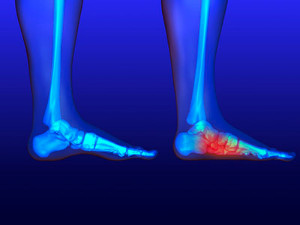 There are several reasons the medical condition that is known as flat feet can exist. These can consist of genetic factors, the aging process, and additional weight gain. This ailment is noticeable while standing on the floor, and observing how the entire foot lies flat. Patients who have flat feet have little or no arch, and this may cause the feet to endure discomfort and strain. Research has indicated that there are specific foot stretches that can be performed, and this may help to reduce the pain from flat feet. If you have this condition, it is suggested that you are under the care of a podiatrist who can help you find the correct treatment options, which may include custom made orthotics.
There are several reasons the medical condition that is known as flat feet can exist. These can consist of genetic factors, the aging process, and additional weight gain. This ailment is noticeable while standing on the floor, and observing how the entire foot lies flat. Patients who have flat feet have little or no arch, and this may cause the feet to endure discomfort and strain. Research has indicated that there are specific foot stretches that can be performed, and this may help to reduce the pain from flat feet. If you have this condition, it is suggested that you are under the care of a podiatrist who can help you find the correct treatment options, which may include custom made orthotics.
Flatfoot is a condition many people suffer from. If you have flat feet, contact Jim Maxka, DPM from South Penn Foot & Ankle Associates. Our doctor will treat your foot and ankle needs.
What Are Flat Feet?
Flatfoot is a condition in which the arch of the foot is depressed and the sole of the foot is almost completely in contact with the ground. About 20-30% of the population generally has flat feet because their arches never formed during growth.
Conditions & Problems:
Having flat feet makes it difficult to run or walk because of the stress placed on the ankles.
Alignment – The general alignment of your legs can be disrupted, because the ankles move inward which can cause major discomfort.
Knees – If you have complications with your knees, flat feet can be a contributor to arthritis in that area.
Symptoms
- Pain around the heel or arch area
- Trouble standing on the tip toe
- Swelling around the inside of the ankle
- Flat look to one or both feet
- Having your shoes feel uneven when worn
Treatment
If you are experiencing pain and stress on the foot you may weaken the posterior tibial tendon, which runs around the inside of the ankle.
If you have any questions please feel free to contact our office located in Hanover, PA . We offer the newest diagnostic and treatment technologies for all your foot and ankle needs.
Flat Feet
Flatfoot is a condition that occurs when the arches on the foot are flattened, which allows the soles of the feet to touch the floor. Flatfoot is a common condition and it is usually painless.
Throughout childhood, most people begin to develop arches in their feet, however, some do not. Those who do not develop arches are left with flatfoot. The pain associated with flat feet is usually at its worse when engaging in activity. Another symptom that may occur with those who have this condition is swelling along the inside of the ankle.
It is also possible to have flexible flatfoot. Flexible flatfoot occurs when the arch is visible while sitting or standing on the tiptoes, but it disappears when standing. People who have flexible flatfoot are often children and most outgrow it without any problems.
There are some risk factors that may make you more likely to develop flatfoot. Those who have diabetes and rheumatoid arthritis have an increased risk of flatfoot development. Other factors include aging and obesity.
Diagnosis for flat feet is usually done by a series of tests by your podiatrist. Your podiatrist will typically try an x-ray, CT scan, ultrasound, or MRI on the feet. Treatment is usually not necessary for flat foot unless it causes pain. However, therapy is often used for those who experience pain in their flat feet. Some other suggested treatment options are arch supports, stretching exercises, and supportive shoes.
Different Forms of Neuropathy
 Research has indicated that many patients who have neuropathy may be diabetic. Peripheral neuropathy is defined as nerve damage that can affect the feet, and can happen from elevated glucose levels in the blood. It can cause the inability to feel sensation, and there may be muscle weakness and slowed reflexes. Patients who have autonomic neuropathy may experience difficulty in swallowing, or have abnormal blood pressures and heart rates. Damage that is inflicted on the hips, thighs, or legs may be indicative of radiculoplexus neuropathy, and this may be linked to diabetes. An additional form of neuropathy is referred to as mononeuropathy, and this may cause difficulty in focusing the eyes. If you are experiencing weakness or a lack of sensation in your feet, it is strongly suggested that you are under the care of a podiatrist.
Research has indicated that many patients who have neuropathy may be diabetic. Peripheral neuropathy is defined as nerve damage that can affect the feet, and can happen from elevated glucose levels in the blood. It can cause the inability to feel sensation, and there may be muscle weakness and slowed reflexes. Patients who have autonomic neuropathy may experience difficulty in swallowing, or have abnormal blood pressures and heart rates. Damage that is inflicted on the hips, thighs, or legs may be indicative of radiculoplexus neuropathy, and this may be linked to diabetes. An additional form of neuropathy is referred to as mononeuropathy, and this may cause difficulty in focusing the eyes. If you are experiencing weakness or a lack of sensation in your feet, it is strongly suggested that you are under the care of a podiatrist.
Neuropathy
Neuropathy can be a potentially serious condition, especially if it is left undiagnosed. If you have any concerns that you may be experiencing nerve loss in your feet, consult with Jim Maxka, DPM from South Penn Foot & Ankle Associates. Our doctor will assess your condition and provide you with quality foot and ankle treatment for neuropathy.
What Is Neuropathy?
Neuropathy is a condition that leads to damage to the nerves in the body. Peripheral neuropathy, or neuropathy that affects your peripheral nervous system, usually occurs in the feet. Neuropathy can be triggered by a number of different causes. Such causes include diabetes, infections, cancers, disorders, and toxic substances.
Symptoms of Neuropathy Include:
- Numbness
- Sensation loss
- Prickling and tingling sensations
- Throbbing, freezing, burning pains
- Muscle weakness
Those with diabetes are at serious risk due to being unable to feel an ulcer on their feet. Diabetics usually also suffer from poor blood circulation. This can lead to the wound not healing, infections occurring, and the limb may have to be amputated.
Treatment
To treat neuropathy in the foot, podiatrists will first diagnose the cause of the neuropathy. Figuring out the underlying cause of the neuropathy will allow the podiatrist to prescribe the best treatment, whether it be caused by diabetes, toxic substance exposure, infection, etc. If the nerve has not died, then it’s possible that sensation may be able to return to the foot.
Pain medication may be issued for pain. Electrical nerve stimulation can be used to stimulate nerves. If the neuropathy is caused from pressure on the nerves, then surgery may be necessary.
If you have any questions, please feel free to contact our office located in Hanover, PA . We offer the newest diagnostic and treatment technologies for all your foot care needs.
Should I Gradually Increase My Running Mileage?
The warm months of the year may encourage people to pursue the sport of running. This is considered to be a popular hobby, and methods can be implemented that may help to prevent running injuries from occurring. These can consist of wearing shoes that fit correctly, alternating between running and walking, and gradually increasing the mileage that is run each week. Research has indicated that it is best to let your feet rest between runs, and drinking plenty of water may help to increase hydration. There are numerous injuries that can happen to the feet while running, and it is suggested to consult with a podiatrist for additional ways on how to prevent running injuries.
All runners should take extra precaution when trying to avoid injury. If you have any concerns about your feet, contact Jim Maxka, DPM of South Penn Foot & Ankle Associates. Our doctor will treat your foot and ankle needs.
How to Prevent Running Injuries
There are a lot of mistakes a runner can make prior to a workout that can induce injury. A lot of athletes tend to overstretch before running, instead of saving those workouts for a post-run routine. Deep lunges and hand-to-toe hamstring pulls should be performed after a workout instead of during a warmup. Another common mistake is jumping into an intense routine before your body is physically prepared for it. You should try to ease your way into long-distance running instead of forcing yourself to rush into it.
More Tips for Preventing Injury
- Incorporate Strength Training into Workouts - This will help improve the body’s overall athleticism
- Improve and Maintain Your Flexibility – Stretching everyday will help improve overall performance
- “Warm Up” Before Running and “Cool Down” Afterward – A warm up of 5-10 minutes helps get rid of lactic acid in the muscles and prevents delayed muscle soreness
- Cross-Training is Crucial
- Wear Proper Running Shoes
- Have a Formal Gait Analysis – Poor biomechanics can easily cause injury
If you have any questions, please feel free to contact our office located in Hanover, PA . We offer the newest diagnostic and treatment technologies for all your foot care needs.
Possible Foot Ailments Related to Diabetes
 Foot conditions can be common among diabetic patients. The risk for specific foot ailments to develop may be reduced by controlling the insulin levels in the blood. Patients who have elevated sugar levels may notice changes in their feet. This can be a result of poor circulation, which may cause the feet to feel cold, tingling, or numb. It may be difficult to feel existing wounds, cuts, or bruises on the feet, and this may cause foot ulcers to develop. It is beneficial to maintain proper foot care on a regular basis. This can be accomplished by soaking the feet in warm water, and covering any wounds with a dry bandage. The feet will feel better when properly fitted shoes are worn, and socks are changed daily. If you have diabetes, it is strongly recommended that you are under the care of a podiatrist who can effectively treat foot conditions that are caused by this ailment.
Foot conditions can be common among diabetic patients. The risk for specific foot ailments to develop may be reduced by controlling the insulin levels in the blood. Patients who have elevated sugar levels may notice changes in their feet. This can be a result of poor circulation, which may cause the feet to feel cold, tingling, or numb. It may be difficult to feel existing wounds, cuts, or bruises on the feet, and this may cause foot ulcers to develop. It is beneficial to maintain proper foot care on a regular basis. This can be accomplished by soaking the feet in warm water, and covering any wounds with a dry bandage. The feet will feel better when properly fitted shoes are worn, and socks are changed daily. If you have diabetes, it is strongly recommended that you are under the care of a podiatrist who can effectively treat foot conditions that are caused by this ailment.
Diabetic foot care is important in preventing foot ailments such as ulcers. If you are suffering from diabetes or have any other concerns about your feet, contact Jim Maxka, DPM from South Penn Foot & Ankle Associates. Our doctor can provide the care you need to keep you pain-free and on your feet.
Diabetic Foot Care
Diabetes affects millions of people every year. The condition can damage blood vessels in many parts of the body, especially the feet. Because of this, taking care of your feet is essential if you have diabetes, and having a podiatrist help monitor your foot health is highly recommended.
The Importance of Caring for Your Feet
- Routinely inspect your feet for bruises or sores.
- Wear socks that fit your feet comfortably.
- Wear comfortable shoes that provide adequate support.
Patients with diabetes should have their doctor monitor their blood levels, as blood sugar levels play such a huge role in diabetic care. Monitoring these levels on a regular basis is highly advised.
It is always best to inform your healthcare professional of any concerns you may have regarding your feet, especially for diabetic patients. Early treatment and routine foot examinations are keys to maintaining proper health, especially because severe complications can arise if proper treatment is not applied.
If you have any questions please feel free to contact our office located in Hanover, PA . We offer the newest diagnostic and treatment technologies for all your foot and ankle needs.
Why Do I Have Cracked Heels?
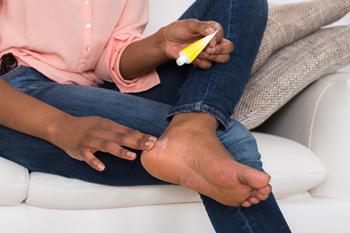 The condition that is referred to as cracked heels can be uncomfortable. In severe cases, where the cracks in the skin are deep, bleeding may occur. These are known as fissures and may become infected if not promptly treated. There are several reasons for this condition to develop that include being obese, standing for long periods of time on hard surfaces, and wearing shoes that have an open back. Mild relief may be felt when the affected heel is washed and dried thoroughly, followed by using a good moisturizer. If you have cracked heels, it is suggested that you speak with a podiatrist who can effectively treat this condition.
The condition that is referred to as cracked heels can be uncomfortable. In severe cases, where the cracks in the skin are deep, bleeding may occur. These are known as fissures and may become infected if not promptly treated. There are several reasons for this condition to develop that include being obese, standing for long periods of time on hard surfaces, and wearing shoes that have an open back. Mild relief may be felt when the affected heel is washed and dried thoroughly, followed by using a good moisturizer. If you have cracked heels, it is suggested that you speak with a podiatrist who can effectively treat this condition.
If the skin on your feet starts to crack, you may want to see a podiatrist to find treatment. If you have any concerns, contact Jim Maxka, DPM from South Penn Foot & Ankle Associates. Our doctor can provide the care you need to keep you pain-free and on your feet.
Cracked Heels
It is important to moisturize your cracked heels in order to prevent pain, bleeding, and infection. The reason cracked heels form is because the skin on the foot is too dry to support the immense pressure placed on them. When the foot expands, the dry skin on the foot begins to split.
Ways to Help Heal Them
- Invest in a good foot cream
- Try Using Petroleum Jelly
- Ease up on Soaps
- Drink Plenty of Water
Ways to Prevent Cracked Heels
- Moisturize After Showering
- Skip a Shower
- Keep Shower Water Lukewarm
- Don’t Scrub Your Feet
If you are unsure how to proceed in treating cracked heels, seek guidance from a podiatrist. Your doctor will help you with any questions or information you may need.
If you have any questions, please feel free to contact our office located in Hanover, PA . We offer the newest diagnostic and treatment technologies for all your foot care needs.
What Are the Different Types of Flat Feet?
Flat feet is a condition known for causing fallen arches, meaning the feet lay completely flat on the floor. There are two different kinds of flat feet one may experience, rigid and flexible. A flexible flat foot has an arch when resting, however, when standing or walking, the arch then disappears. This type of flat foot is often common among pediatric aged patients. A rigid flat foot develops during adulthood due to the weakening of the tibialis posterior muscle tendon. This type of flat foot may worsen over time and can cause pain and swelling in the feet, particularly the inside arch of the foot and ankle. Rigid flat foot may eventually lead to arthritis as well. For a proper diagnosis and recommended treatment plan, it’s suggested that you consult with a podiatrist.
Flatfoot is a condition many people suffer from. If you have flat feet, contact Jim Maxka, DPM from South Penn Foot & Ankle Associates. Our doctor will treat your foot and ankle needs.
What Are Flat Feet?
Flatfoot is a condition in which the arch of the foot is depressed and the sole of the foot is almost completely in contact with the ground. About 20-30% of the population generally has flat feet because their arches never formed during growth.
Conditions & Problems:
Having flat feet makes it difficult to run or walk because of the stress placed on the ankles.
Alignment – The general alignment of your legs can be disrupted, because the ankles move inward which can cause major discomfort.
Knees – If you have complications with your knees, flat feet can be a contributor to arthritis in that area.
Symptoms
- Pain around the heel or arch area
- Trouble standing on the tip toe
- Swelling around the inside of the ankle
- Flat look to one or both feet
- Having your shoes feel uneven when worn
Treatment
If you are experiencing pain and stress on the foot you may weaken the posterior tibial tendon, which runs around the inside of the ankle.
If you have any questions please feel free to contact our office located in Hanover, PA . We offer the newest diagnostic and treatment technologies for all your foot and ankle needs.
How to Know If Your Foot Is Broken
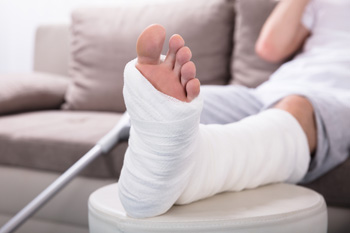 The severity of a broken foot can range from a small fracture to throbbing in the affected foot. If a broken foot is not detected in time, issues such as arthritis, infection, or damage to the nerves and blood vessels may arise. Therefore, if you are experiencing symptoms such as bruising, swelling, numbness, or a foot deformity, such as a broken bone sticking out of the skin, it is important to consult with a podiatrist immediately. During the visit, your podiatrist can check for fractures with various tests that may include x-rays, bone scans, MRIs, and CT scans. After reviewing the results, your podiatrist can then recommend the proper treatment which may include a cast, surgery, and rest.
The severity of a broken foot can range from a small fracture to throbbing in the affected foot. If a broken foot is not detected in time, issues such as arthritis, infection, or damage to the nerves and blood vessels may arise. Therefore, if you are experiencing symptoms such as bruising, swelling, numbness, or a foot deformity, such as a broken bone sticking out of the skin, it is important to consult with a podiatrist immediately. During the visit, your podiatrist can check for fractures with various tests that may include x-rays, bone scans, MRIs, and CT scans. After reviewing the results, your podiatrist can then recommend the proper treatment which may include a cast, surgery, and rest.
A broken foot requires immediate medical attention and treatment. If you need your feet checked, contact Jim Maxka, DPM from South Penn Foot & Ankle Associates. Our doctor can provide the care you need to keep you pain-free and on your feet.
Broken Foot Causes, Symptoms, and Treatment
A broken foot is caused by one of the bones in the foot typically breaking when bended, crushed, or stretched beyond its natural capabilities. Usually the location of the fracture indicates how the break occurred, whether it was through an object, fall, or any other type of injury.
Common Symptoms of Broken Feet:
- Bruising
- Pain
- Redness
- Swelling
- Blue in color
- Numbness
- Cold
- Misshapen
- Cuts
- Deformities
Those that suspect they have a broken foot shoot seek urgent medical attention where a medical professional could diagnose the severity.
Treatment for broken bones varies depending on the cause, severity and location. Some will require the use of splints, casts or crutches while others could even involve surgery to repair the broken bones. Personal care includes the use of ice and keeping the foot stabilized and elevated.
If you have any questions please feel free to contact our office located in Hanover, PA . We offer the newest diagnostic and treatment technologies for all your foot and ankle needs.





